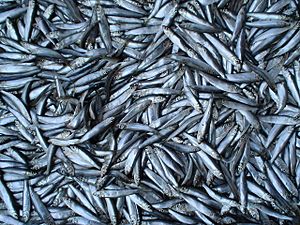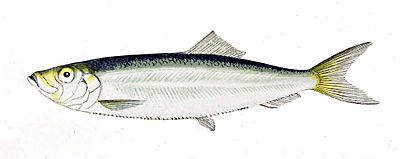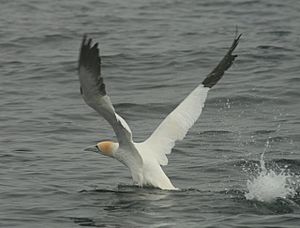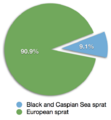Sprat facts for kids

at Odessa bazaar in Ukraine
A sprat is a small, oily fish that swims in large groups. These fish are part of the Sprattus family, but the name "sprat" is also used for other similar small fish. Like many small fish, sprats are very active and swim all day long.
Sprats are known for being very healthy to eat. They are full of good fats called polyunsaturated fats, which are great for your body. People eat sprats in many places around the world. Sometimes, sprats are even sold as other fish, like anchovies or sardines, because they look similar and taste smooth.
Contents
What Sprats Are Like

Sprats are small fish. The time it takes for a sprat egg to hatch is about 15 days. How well young sprats grow depends a lot on their environment. Things like water temperature, how salty the water is, and how deep the water is all play a big part.
For example, in the Baltic Sea, these factors really affect how many sprats survive. Over the years, the number of sprats has changed. This is mainly because of how much zooplankton (tiny sea creatures) they have to eat. Also, changes in the total number of other fish in their family (Clupeidae) can affect them.
Even though sprat numbers went down in the late 1980s and early 1990s, they have increased a lot in the last 20 years. This means more sprats are growing up and having babies. One big problem for sprats is very cold winters. Cold temperatures, especially in the Baltic Sea, can stop sprat eggs and young fish from developing well.
Sprats are very active fish, so they use a lot of energy. Their body's energy use (metabolic rate) changes a lot with water temperature. Other fish, like the Atlantic Herring, use less energy. Sprats use more energy because they are always swimming and moving throughout the day.
Where Sprats Live
You can find different kinds of sprats in many parts of the world. They live in places like New Zealand, Australia, and parts of Europe. The most studied place where sprats live is the Baltic Sea in Northern Europe. This sea is a great home for sprats, especially the Sprattus sprattus type. It has many different areas that help them reproduce successfully.
One famous spot in the Baltic Sea where sprats find food is the Bornholm Basin. This is in the southern part of the Baltic Sea. Even though the Baltic Sea has changed a lot in the last 20 years, the sprat population has grown a lot. One change in the Baltic Sea since the 1980s is that the water has become less salty. This is because less salty, oxygen-rich water flows in from the North Sea.
What Sprats Eat and Who Eats Them

In the Baltic Sea, cod, herring, and sprats are very important fish. Cod are the main hunters, while herring and sprats are mostly the prey. Scientists have looked inside the stomachs of cod and found sprats, which shows that cod eat them.
However, sprats also eat cod! They like to eat cod eggs and young cod larvae before the cod grow up. Sprats and herring also compete for the same food. They both try to find the limited zooplankton available in the Baltic Sea. They even swim up and down in the water to find the best spots for food.
Sprats are picky eaters. They only eat zooplankton, no matter how big they get. They don't change their diet like some other fish do. The types of zooplankton they eat depend on the environment, like temperature, which affects what food is available.
In autumn, sprats often eat Temora longicornis and Bosmina maritime. In winter, their diet changes to include Pesudocalanus elongates. This type of zooplankton is very important for fish in the Baltic Sea.
Sprats usually avoid eating Acartia species. This is because Acartia are very small and can escape predators like sprats and herring easily. Even if there are many Acartia, sprats tend to stay in deeper water during the day, while Acartia live closer to the surface.
Sprats as Food
In Northern Europe, European sprats are often smoked and kept in oil. This gives them a strong, smoky taste.
Sprats are very healthy because they have special fats called polyunsaturated fatty acids. These include EPA and DHA. These good fats are found in sprats in amounts similar to Atlantic salmon. Sprats can even have up to seven times more EPA and DHA than some other common fish. These fats are good for your brain, nerves, and heart.
Images for kids






